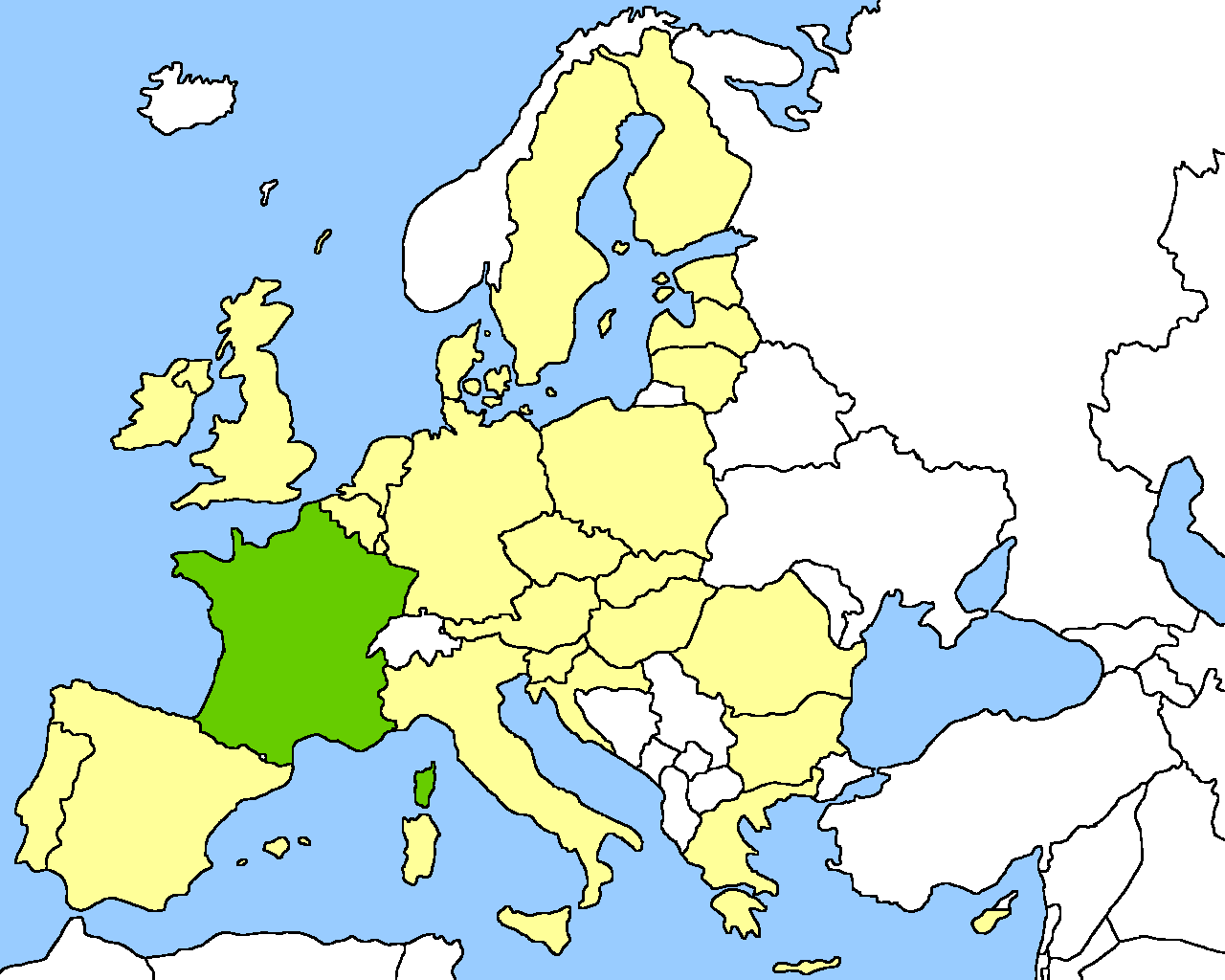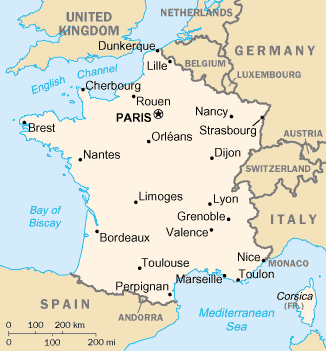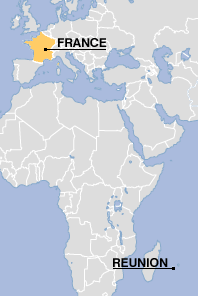Location and cultural history
One tends to think of France as a country wholly within Europe. Not so. Metropolitan France (French: France Métropolitaine or la Métropole), is the part of France located in Europe. That comprises the French mainland plus the Mediterranean island of Corsica. By contrast, Overseas France (la France d’outre-mer) is the collective name for the French overseas departments (départements d’outre-mer), territories (territoires d’outre-mer), and collectivities (collectivités d’outre-mer). Metropolitan France and Overseas France together form what is officially called the French Republic (La République Française).
Metropolitan France accounts for 81.8% of the territory and 95.9% of the population of the French Republic [2011].
The four overseas departments ‑ Réunion, Guadeloupe, Martinique and French Guiana ‑ have the same political status as Metropolitan France’s departments. Metropolitan France and these four overseas departments together are sometimes called France Entière ("entire France") by the French administration, especially by the government statistical office INSEE, although in reality this France Entière does not include the French overseas collectivitiés and other territories which have greater autonomy than the overseas départments.
When interpreting statistics about France it is important to bear in mind that, since the end of the 1990s, INSEE has routinely included the four overseas départments in its figures for France, but not the overseas collectivitiés and other territories.
 |
 |
France - Location within the European Union. |
The term “Metropolitan France” includes Corsica. |
 |
 |
 |
Locations of the four overseas Départements. For the purpose of government statistics, these are integral parts of France. |
||
The history of France prior to World War One has little bearing on circumcision rates today, so we need not consider in detail the French Revolution and events such as the Storming of the Bastille on 14 July 1789, or the Napoleonic Wars (1803‒1815). That is not to say that circumcision did not take place in France, just that it was (as we shall see) a function of local culture rather than socio-political events.
What is relevant is the more recent history, especially the decolonisation of francophone North and West Africa that followed the Second World War. In some instances this relinquishing of colonial power was fiercely opposed within France itself, notably in respect of Algeria by the OAS (Organisation de l’Armée Secrète) whose activities were dramatised in the novel The Day of the Jackal (author Frederick Forsyth, 1971) and subsequent film of the same name (Universal Pictures, 1973).
The long-term result of France’s colonial past is that it has, as a percentage of total residents, the highest Muslim population in Western Europe. According to research by the Pew Forum, in 2010 4.7 million residents of France were Muslim. That represents 7.5% of the total population. This is projected to rise to 10.3% by 2030.
Adding the expected 7.5% of medically-necessary circumcisions (phimosis, donor tissue for hypospadias repair and so on) suggestes a minimum circumcision rate of 15% as at 2010.
A French anti-circumcision group l’Association contre la Mutilation des Enfants at one time claimed on a French website (which is no longer functional) that the medical circumcision rate was 15%: En France, outre les juifs et les musulmans, plus de 15% des garçons sont circoncis officiellement pour phimosis (étroitesse du prépuce). (In France, apart from Jews and Muslims, more than 15% of boys are circumcised officially for phimosis (narrowing of the prepuce)). If true, that would place the likely total circumcision rate at around 22.5% in 2010 with a projected rise to around 25% by 2030.
A French reader, JM, has recently (October 2021) made a survey of the site Ma-Queue (literally 'my tail', colloquially 'my dick') where men, mostly gay, post pictures of their members. It is a French language site and so attracts French-speaking Belgians as well as Frenchmen. Of the overall number of members who gave their circ status (4240 members), 608 are cut, 14.3% of total members. With men from France the rate is 13.8% and from Belgium, 19.6% (over a smaller sample of 171 members).
Here is JM's breakdown of the total survey by age:
| Age group (18+) | % circumcised |
| 18-25 | 15.5% |
| 25-30 | 15.1% |
| 30-35 | 13.1% |
| 35-40 | 10.5% |
| 40-50 | 13.8% |
| 50-60 | 17.2% |
| 60-70 | 22% |
| 70+ | 22.3% |
In the older age groups (60+), the sample is just over 200 members so it may not be statistically signficant. But it gives a nice trend - the oldest are the most circumcised, and the younger generations are becoming more circumcised than people in their thirties. (Or, I suppose, young circumcised men are more willing to share details about their cock.) JM
The number of 'roundheads' in France is clearly enough to make them a market worth targeting. French condom manufacturer Polidis has realised that a growing number of its customers do not have foreskins and have launched a special model for them, Reflex Condoms CIRCUM'SIZE. Details at their website.
Review of a 19th century French treatise on circumcision
Contributed by David Parris
De la circoncision au point de vue historique et médical
Ernest Abram, Docteur en médecine, Montpellier, 1864. 115pp.
A while back I purchased a copy of this 19th Century French treatise on circumcision. What follows is a résumé of the essential points, followed by some comments of my own. The title translates as “Circumcision from the Historical and Medical Viewpoint”. The fly-leaf bears a quotation from Malgaigne’s work “Lettre sur l’histoire de la chirurgie”:
La première opération fut la circoncision et le premier opératieur Abraham ‒The text is divided into a historical part (pp.1‒60) and a medical part (pp.61‒115).
The first operation was circumcision, and the first surgeon Abraham.
The historical part is largely devoted to speculation on the origins of circumcision, and the question ‘Who invented circumcision?’ Three hypotheses are presented:
- The Jews were the first to circumcise;
- The Jews borrowed the practice from the Egyptians;
- Circumcision was an oriental practice that cannot be attributed to anyone in particular.
2. The view that it was an Egyptian invention is supported by Herodotus (book 2 chapter 114), Diodorus of Sicily, Strabo. Josephus, in countering Apio, seeks to accept Herodotus’s view. Tacitus merely repeats the majority opinion of older authors. Celsus (quoted in Origenus) thinks circumcision was the invention of Egyptian priests, as did the Emperor Julian. Voltaire is severely criticised not just for following Herodotus (like Marsham) but for mistranslating him and for a hostile attitude to the Jews. According to Voltaire, the Jews, who lived in Egypt for 205 years, only took over the custom 40 years after they had left Egypt. If the Jews did not circumcise while in Egypt, might one not conclude the practice was as yet not established in Egypt? Though Clement of Alexandria says Pythagoras had to be circumcised to gain admittance to the temple library, there is a gap of 1500 years between Abraham and Pythagoras during which the practice of circumcision might have been introduced to Egypt, possibly by Joseph. An article by Professor Malgaigne (1842) is quoted to suggest that Herodotus cannot be correct because he was writing 1400 years after the events he is dealing with.
3. Sanchoniaton (Phoenician, 1364 BC) is the next earliest (and hence credible) author after Moses to deal with the subject, and claims their King Kronos was the first to circumcise himself, after sacrificing his son.
Abram considers it unlikely that circumcision was taken by the Jews from another people, because of the difference in the nature of the rites. The Egyptians circumcise women as well as men, and in early adulthood. The Jews circumcise only men, in the eighth day of life.
After the consideration of the origins of circumcision, Abram turns to its history. When in 2059 (Jewish calendar) Abraham instituted circumcision amongst the Jews, only the part of the foreskin that hung beyond the glans was removed. This was still the case when the Jews were in the desert. It might have been at the time of the Machabees that a second part of the operation was introduced so as to leave the glans completely uncovered and thus prevent the accumulation of smegma (‘sebaceous humour’).
From then on, the history of circumcision is stated to be unclear and difficult to disentangle from persecutions, many of which involved the prohibition of circumcision. The practice was abandoned early in the history of the Church, under the influence of Saint Paul. Under Trajan, Adrian subjugated the Jews and forbade circumcision. Antoninus allowed it again, but Marcus-Aurelius reintroduced the Prohibition. The Emperor Heliogabalus was himself circumcised, and his successor Alexander Severus who wanted a synthesis of the Jewish, pagan and Christian religions, ushered in a period of tranquillity for the Jews.
Persecutions began anew under Constantine. Julian the Apostate allowed Jews the free practice of their religion. In the 6th century Jews were forbidden to bring their children up as Jews. In the 7th century, Heraclius having been told his ruin would come from a circumcised people saw the Jews as his enemies. However, Charlemagne was indulgent, and in the 12th century St.Bernard showed tolerance. This was a great age of Jewish scholarship. The Jews further suffered under the Spanish inquisition. However, circumcision thrived in periods of repression.
Abram's views do not reflect modern scholarship - see our History and Judaism pages. (Ed).
The medical part of the book begins with the assertion that it is not surprising that people in hot climates often sought to rid themselves of a body part that caused so many problems. A sebaceous secretion comes from follicles at the base of the glans and accumulates under the prepuce, necessitating careful hygiene which is often neglected especially where the to foreskin is too tight. It can then ferment, giving off a foul odour and leading to balanitis and posthitis.
Cases of seamen or workers with severe infections and an abundant discharge, but who claimed to have had no sexual relations are cited. Others claimed the discharge due to women who, when examined, turned out to be perfectly healthy. The symptoms of balano-posthitis are stated to be a certain burning and a slight itch. The glans and foreskin are at first red and dry, but a milky discharge soon appears, taking on a pustulating appearance. If the foreskin is long and tight, urination may be painful. Where the glans and foreskin can be examined, they are red and shiny, bathed in a cheesy mucus. Retraction of the foreskin becomes difficult, and where achieved, leads to paraphimosis, which can lead to gangrene of the end of the penis.
The situation may be treated with a silver nitrate solution (2gms to 200gms of distilled water) after which a dry lint is placed between the foreskin and the glans. If there are deep ulcers or enlargement of the sebaceous glands, cauterisation with a silver nitrate pencil may be necessary. In cases of phimosis, the solution may have to be injected under the foreskin. Although these remedies may cure the inflammation, they offer no guarantee against further problems, since the root cause subsists.
Masturbation is often due to a long foreskin. Before puberty, the genitals should be in a state of inertia (! Ed). Stimulation can bring about a pleasure which the subject will seek to repeat. Dr.Tissot’s book L’Onanisme (1760) shows the dangers of this pernicious practice, leading to blue rings round the eyes, pale complexion, dull, sunken eyes, bad digestion, lack of appetite, loss of weight, leaden complexion, weak voice, dry cough, palpitations, nervousness, poor vision, vertigo, trembling, cramps and occasional fits.
There follows a series of cases borrowed from one Dr.Lallemand:
- Long foreskin, small genitalia, delicate constitution, early but infrequent masturbation, impotence from age 19 to 29, poor health, loss of semen during urination or defecation. Excision of prepuce and cauterisation of the prostatic section of the urethra is reported as having produced swift and complete recovery.
- Excessively long foreskin, very small genitalia, masturbation from the age of 9, weakening and stiffening of the muscles. At 19, permanent catheterisation of the urethra; excision of the prepuce and cauterisation of the bladder & the urinary tract is reported as having produced rapid improvement and probable full recovery.
- Natural phimosis. From puberty on, frequent “nocturnal pollutions” (ejaculation), foul-smelling smegma. Circumcision at age 23 is reported as producing immediate recovery.
After long and serious reflection on the numerous things I have seen, I remain convinced that it is to be regretted that circumcision has fallen out of use as an obligatory operation for all children. It would be of no use in many cases, but would be harmful in none, and might be of use to a great number.Finally, there is a section on methodology. The Bible says nothing about how to perform the operation, except that flint knives were used. The Talmudic prescriptions have serious disadvantages which could be obviated. The mohel’s practice falls into three parts:
- Cutting - hitush. The foreskin is drawn through a slit in a protective plate. Care must be taken to ensure the skin and mucous are pulled through in the right proportions, because you almost always take away more skin than mucous.
- Laying bare - periah. The tearing of the remaining inner mucous is painful, and almost barbarous. Various mechanical devices would do the job better.
- Sucking - mezizah. The mohel takes a mouthful of wine and sucks the wound. This is unhygienic and dangerous. Several boys having been infected by a single mohel, the Paris consistory forbade the practice (1844).
Surgical practice varies. There is incision, excision and circumcision:
- Incision is a dorsal or ventral slit.
- Excision is the removal of part of the foreskin. Lisfranc’s method, similar to Dupuytren’s procedure for cancer of the lip, uses curved scissors to remove a half-moon of flesh. Taxil’s procedure removes a V-shaped section which includes the frenulum.
- Circumcision removes all the foreskin all the way round. It is the most frequent procedure; there are several methods. Guilleumeau’s procedure, attributed to Lisfranc, is that of the mohel: an assistant pulls the foreskin forward, the surgeon clamps it, and using scissors or a scalpel removes all the overhang. Healing can be hastened and a more even scar achieved by Ricord’s procedure (1843): the skin is kept in its usual position, and an ink line traced following the base of the glans right the way round, 5 or 6 millimetres forward of the base. A slotted clamp is then used to insert sutures before the skin is severed. After, cold compresses are applied, and healing is normally complete after 6 days.
Vidal, from Cassis, uses clips instead of sutures. The foreskin is pulled forward and a clamp is put in place at an angle so the more is removed from the dorsal side of the glans. The skin is then cut between the glans and the clamp. Clips are then inserted for 24 hours. The disadvantage is that the end of the glans is exposed to damage. Nevertheless, Vidal’s method is the most widely used.
A military surgeon, Dr.Chauvin, devised an apparatus consisting of a pair of tongs with round ends, and a four-branched apparatus with a claw at the end of each branch which is pushed under the foreskin. Once inside, these spring out and the claws engage on the foreskin. The glans is pushed down as far as it will go, and clamped in place. The mucous is thus pulled forward, while the outer skin is pushed backwards. The surgeon then uses strong scissors to cut through the foreskin and the handle of the apparatus pushed down the foreskin. The object of this complex method was to avoid ending up with too much mucous. It was successfully used by its inventor, but was taken up by no one else.
A few personal comments from David Parris:
The whole book reveals a deep interest in the subject, perhaps an example of the general preoccupation with human sexuality in the 19th century. The historical part is in many ways disappointing. The question of who invented circumcision pales into insignificance alongside the overriding reflection that whoever it was, it is a jolly good idea. However, the discussion reveals a considerable number of authors and a body of texts. Some of the discussions were prolonged in the 20th century, for example by Freud in Moses and Monotheism whose hypothesis of the name Moses and the Egyptian origins at least deserve examination.
There is little doubt that the book’s author Abram was Jewish at least on his father’s side (his mother’s family had less obviously Jewish names). Although enough of a rationalist to object to some aspects of traditional mohel practice, his sympathy is emotionally on the side of the Jews. It is possibly because of this that he leaves out of account an important fact. The Phoenician Kronos, sacrificed his son and circumcised himself. Abraham nearly sacrificed his son and circumcised himself. Sacrifice stories are frequent in antiquity (Saturn, Agamemnon). But the combination of both the sacrifice of a son and also circumcision seems more than could reasonably be attributed to chance. The conclusion from which would be that both stem from a single ancient myth or event.
Dr.Tissot’s book on masturbation was one of the most influential in medical history, and was in print from 1790 up to 1905. The view that masturbation lead to a variety of ailments brought about an interest first in gymnastics. In Germany and Sweden in particular, a fear that boarding schools could lead to an excess of masturbation unless preventative measures were taken gave rise to regular sports, in part as a way of making young men too tired to masturbate.
The descriptions of the problems brought about by the lack of circumcision (balanitis &c) strike one as very modern. But there is no allusion to any other associated problem, such and urinary tract infections. The enthusiastic endorsement of the procedure thus only rests on a part of the evidence. The descriptions of the absence of hygiene are horrifying. The collection of vast stones from under the foreskin seems to have been almost a competitive sport among medical men of the age. The numbers of operative procedures discussed, and the numbers of eminent doctors mentioned seem to show that Abram was not alone in his opinions, also that there was a considerable and widespread interest in the subject. The quotation from Dr.Lallemand that he regretted that circumcision had fallen out of use is intriguing. I have seen no other evidence that it was ever the norm in France. It is just conceivable that Dr.Lallemand was Jewish, and regretted that it was no longer the norm in the Jewish community, but there is absolutely no evidence that this was the case. One must recall that all the procedures described were undertaken without anaesthetic.
Editor's comment: I think that Lallemand meant that he regretted that the Christian Church had abandoned the Jewish practice.
Regular correspondent AM has come across an earlier French thesis making much the same points as Abram and Lallemand, and surely a source of influence for both of them. A summary follows.
Dr. Moyse Cahen, 'Dissertation sur la Circoncision,' 1816, submitted to the Faculty of Medicine of Paris, published by Didot.
The author had already been a military surgeon. He refutes the criticisms made about circumcision and seeks to prove that Moses was guided in his conduct by considerations of hygiene and public health. The thesis is divided into three parts:
- proofs of its origin and antiquity,
- the way circumcision is practised in the various countries of the Orient, in particular by the Jews,
- its influence on the health of nations which practice it, and on their populations.
Dr Cahen practised in Paris. He was a member of the Paris Jewish Welfare Committee from 1816 to 1840.
It would seem that there was quite a push for widespread circumcision in 19th century France, largely by Jewish doctors, but it clearly didn't get very far.
Correspondence received
Havinng lived almost all my life in France, I have to say that circumcision is not widely spread in our country except, of course, in the Jewish or Muslim communities. More precisely, neonatal circumcision is rarely practiced. French people don’t understand why circumcision should be done, either at birth or later, except for medical reasons and in this case, the doctors try to circumcise as few as possible. They seem to consider male circumcision as useless and unnecessary. This can maybe be explained by the Roman Catholic background of almost all the population from European origin. So, many people, especially the females, don’t even know that this surgery exists and when they see a cut penis or when we speak of circumcision, they do not understand. Even the word ‘coupe’ which is the exact translation of ‘cut’ is a synonymous with castrated, not of circumcised.
When I was born, the doctor told my mother that it would be better to circumcise me because my foreskin was very long and had a bad overhang. My Catholic mother refused, telling him that circumcision is only needed for dirty people. The doctor was right and it was impossible to discover the glans during childhood. When I was 12, I tried to retract my foreskin and little by little I succeeded, but it was not really pleasant. When I saw my glans so smooth (but the smell was not good), I immediately liked it in this way and tried to let it in this state. Unfortunately, the foreskin always recovered over my glans. With the time and the beginning of my sexual life, I forgot it. Some years later, I got married to a black french female (I am a white male) who quickly liked to be without hair. She removes her hair (legs, genitals, armpits). The view of her hairless body has been so delightful that I discussed with her my preference for circumcision. She agreed with me, and I decided to be circumcised. It was not so easy to do the step because of what we can named a French taboo concerning this little surgery.
At that time I worked in Africa where it was difficult to get regularly water to take at least a shower. So I grasped this reason and during vacation I asked a doctor to circumcise me. He asked nothing, examined my penis and sent me to a surgeon.
The surgery was easy and carried out quickly during an afternoon under general anesthetic. At midday I arrived in the hospital having eating nothing from the morning and at 6 PM I left the building minus a few square centimeters of skin. It healed in 2 weeks and my wife and I waited one week more to have sex. Actually I do not remember any pain and it seems to me that it was easy and almost pleasant.
The first thing I remarked was the lack of smell the day after the surgery and I was very happy of this fact. The second thing my wife noticed later was when erected the glans could not be re-covered by the skin so she was obliged to change a little her way to masturbate me. More generally she liked (and still likes) my bare glans as I like her hairless genitals.
Contrary to what is commonly reported, I did not feel any loss of sensitivity and also it seems that there is no prolongation of the period before ejaculation. In truth, neither I or my wife have remarked on any change in the quality of our sexual life; maybe because we did not expect any thing in this domain.
Paul - Paris
I agree that only a small minority is circumcised in France. Neonatal circumcision is not a local custom. In my generation (I am 28), I estimate that from 10% to 15% of boys were circumcised, many of them done in childhood. I was circumcised at age 9. For the yearly school physical visit, the doctor used to verify that we had 2 testicles and no hernia. The year he visited my school (age 9), he tried to roll back the foreskin. Just a very quick try; he didn’t succeed and continued the exam. I forgot about this, but a letter was sent home to my parents. A few days later, my mother came into the bathroom (I used to wash myself by this time).
| Maman: | “Do you clean your penis?” | |
| Moi: | “Yes of course.” | |
| Maman: | “Can you do it?” | |
I put soap on my penis. |
||
Maman: |
“Good, but can you wash it everywhere?” |
|
I didn’t answer. I remembered that she used to retract my foreskin when I was a little boy. But I didn’t like this and I had stopped doing it. I tried to roll back the skin but nothing occured. My mother told me to finish my bath and left the room.
A few days later, we went to a hospital. I showed my penis to a doctor and he trid to roll back the foreskin. He was unsucessufully and it was very painful. Then, he explain that he was obliged to operate on me to remove the tight skin. I rremember being very afraid, not because of a modification of my penis, but because of being put to sleep. (I knew what a circumcised penis looked like and had no specific preference about it). During the spring holidays, I was circumcised. One week with a painful penis and then it was all over. I had no shame in removing my pants in the locker room as there were already two or three other circumcised boys in the group.
Today books tell parents not to touch a baby’s foreskin. But a few of them say that circumcision is a minor operation and can avoid a lot of problems later. But every doctor has his method. Our pediatrician tried to roll back the foreskin of our son when he was a 3 month old baby. And at 5 years old, for the first school exam, the doctor also tried to do it. According to his recommendations, our son has to be circumcised and we are going to comply with the recommendation. I know that several of his classmates have been circumcised also, during this same time.
Chase (France)
We are a UK family who spend a lot of time in France where we own a second property. During one visit, our 3-year old was taken ill which required a trip to the doctor. The young lady GP looked to be not long out of medical school and gave him a very full examination. This required removing his underpants, revealing that he was circumcised. Quelle surprise! She appeared quite shocked as if she’d never seen a circumcised penis before and quizzed us for ages about it. We explained we’d had him done privately soon after birth for personal not religious or medical reasons. She was incredulous.
Since then we’ve learned that circumcision outside the religious communities in France is quite rare. Obviously rare enough for this doctor to be so naïve and curious about it.
Anon - UK
[Editor’s note: Several commentators have suggested that there is a major difference between circumcision rates in the main cities of Metropolitan France and the rural areas.]
Acknowledgements
The following resources were used in the preparation of this web page:
Wikipedia.
Personal testimony of members of the CIRCLIST discussion group.
Research by Pew Forum.



